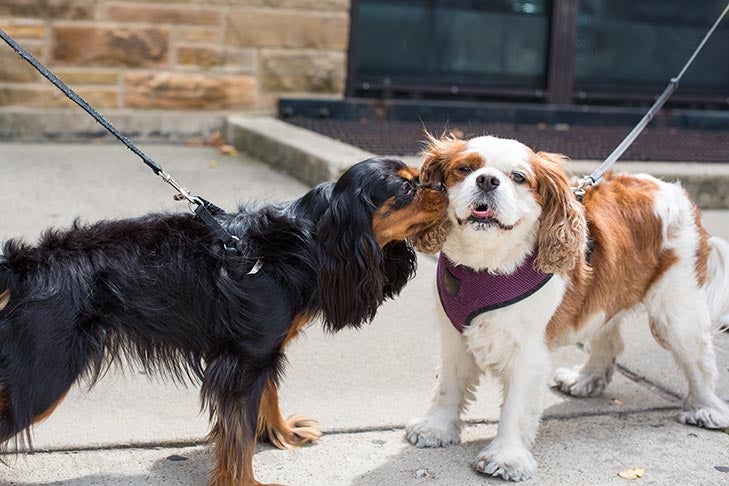How to Introduce My Dog to a New Dog
Dogs are social animals and most enjoy the company of others. Just like humans, some dogs have more outgoing personalities, and others are more reserved. Whether you just brought home a new puppy and are introducing him to an existing dog or you are walking at a park with your dog, a proper introduction is very important.
Introducing a New Puppy to Your Dog
You finally picked out your new puppy and are ready to pick him up and bring him home. Everyone is excited for the new addition, but will Fido at home feel the same way?
It is important to understand that puppies are still developing their communication skills. This means that they don't understand the rules set in place by adult dogs.
When they first enter their new home, puppies have a lot of rules to learn, both from you and the existing dog. Puppies immediately start looking for someone to play with and when they can't find another puppy, the adult dog is the next best thing. Your dog may or may not appreciate this! As long as an adult dogs' behavior is appropriate when correcting a puppy, it's okay if they growl or grumble at the new addition. This is the way older dogs communicate that the puppy has crossed the line, and it is acceptable as long as the adult dog does not make inappropriate contact and injure the puppy.
Do not reprimand the adult dog for growling at the puppy. This is how dogs let others know that they are unhappy about something. Growling can let the puppy know that it is time to take a step back from the situation and that is a good lesson for your puppy to learn.
To make sure interactions stay appropriate and the elder dog is not overwhelmed, supervise all interactions between the dogs. If you notice that the elder dog is becoming agitated by the puppy, it is time to separate or redirect the puppy to another task before things get out of hand. When you are not able to directly supervise the puppy, he should be placed behind a gate, in an exercise pen or in a crate.
You should give the elder dog a break from the puppy several times during the day; this can be carried out by crating either dog. Periods of separation during the day can take the pressure off the elder dog and give both dogs much needed breaks.
When you are supervising interactions, reward both dogs for behaving appropriately. Make sure your puppy is getting enough exercise, both mental and physical, so all his attention is not focused on the older dog. A great activity is taking both dogs on a walk. Eventually, with an introduction that has not been rushed, the puppy will develop the communication skills he needs to succeed, and your dogs will be great friends.

Introducing Your Dog to a Strange Dog:
It is almost guaranteed that when you and your canine buddy are out on a walk, you will come into contact with another dog.
Always ask the other owner if an interaction with their dog is okay. Some dogs may be timid or reactive, and interactions with them may not be ideal for either dog. If a meeting has been approved by both you and the other owner, you can proceed to let the dogs meet. Some dogs may act differently on a leash than they do when off-leash. This can be due to feeling trapped and that they cannot get away if an altercation occurs.
Once they come in contact, normal dog behavior will likely occur, and the dogs will sniff each other in greeting. Signs that the meeting is going well include relaxed facial expressions, play bows, tails wagging fast, and wiggling their hind ends.
Signs that the meeting is too much for either dog may include yawning, turning their heads away from the other dog, tense jaws, tails held low, shaking, and the hair standing up along their backs. These behaviors indicate the dog is nervous about the meeting, and it is best to separate the dogs and continue on your walk before the situation has a chance to escalate.
Don't let your dog meet every dog they see on a walk; switch it up and ask for periods of focus on you when passing another dog. This helps prevent Rover from lunging at every dog he passes, including those dogs that are uncomfortable with other dogs.
Dog-to-dog interactions are an important part of dog ownership. When performed correctly, they can be enjoyable for everyone. Remember to always take meetings slow, and if any dog appears to be nervous or anxious about the situation, increasing the distance is best. With well-trained greetings, your dog will happily anticipate the fun that they can have with other four-legged friends.
How to Introduce My Dog to a New Dog
Source: https://www.akc.org/expert-advice/training/how-to-introduce-dogs/
0 Response to "How to Introduce My Dog to a New Dog"
Post a Comment